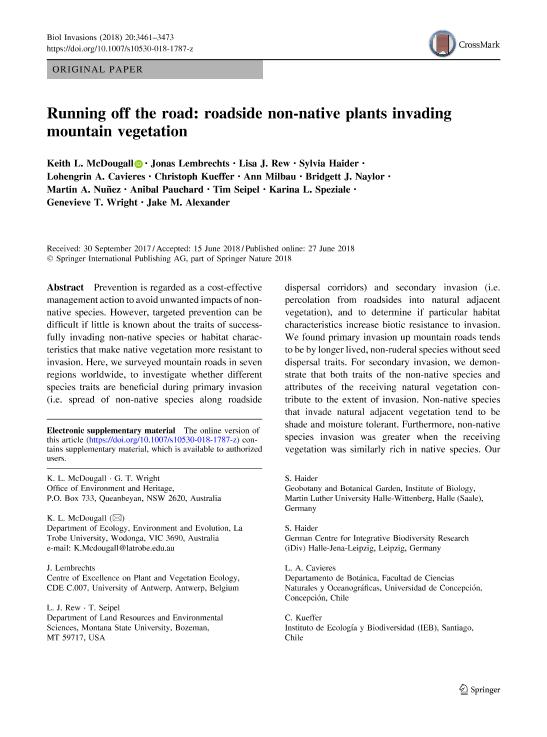Artículo
Running off the road: roadside non-native plants invading mountain vegetation
McDougall, Keith; Lembrechts, Jonas; Rew, Lisa J.; Haider, Sylvia; Cavieres, Lohengrin A.; Kueffer, Christoph; Milbau, Ann; Naylor, Bridgett J.; Nuñez, Martin Andres ; Pauchard, Anibal; Seipel, Tim; Speziale, Karina Lilian
; Pauchard, Anibal; Seipel, Tim; Speziale, Karina Lilian ; Wright, Genevieve T.; Alexander, Jake M.
; Wright, Genevieve T.; Alexander, Jake M.
 ; Pauchard, Anibal; Seipel, Tim; Speziale, Karina Lilian
; Pauchard, Anibal; Seipel, Tim; Speziale, Karina Lilian ; Wright, Genevieve T.; Alexander, Jake M.
; Wright, Genevieve T.; Alexander, Jake M.
Fecha de publicación:
27/12/2018
Editorial:
Springer
Revista:
Biological Invasions
ISSN:
1387-3547
Idioma:
Inglés
Tipo de recurso:
Artículo publicado
Clasificación temática:
Resumen
Prevention is regarded as a cost-effective management action to avoid unwanted impacts of non-native species. However, targeted prevention can be difficult if little is known about the traits of successfully invading non-native species or habitat characteristics that make native vegetation more resistant to invasion. Here, we surveyed mountain roads in seven regions worldwide, to investigate whether different species traits are beneficial during primary invasion (i.e. spread of non-native species along roadside dispersal corridors) and secondary invasion (i.e. percolation from roadsides into natural adjacent vegetation), and to determine if particular habitat characteristics increase biotic resistance to invasion. We found primary invasion up mountain roads tends to be by longer lived, non-ruderal species without seed dispersal traits. For secondary invasion, we demonstrate that both traits of the non-native species and attributes of the receiving natural vegetation contribute to the extent of invasion. Non-native species that invade natural adjacent vegetation tend to be shade and moisture tolerant. Furthermore, non-native species invasion was greater when the receiving vegetation was similarly rich in native species. Our results show how mountain roads define which non-native species are successful; first by favouring certain traits in mountain roadsides (the key dispersal pathway to the top), and secondly by requiring a different set of traits when species invade the natural adjacent vegetation. While patterns in species traits were observed at a global level, regional abiotic and biotic variables largely generated region-specific levels of response, suggesting that management should be regionally driven.
Archivos asociados
Licencia
Identificadores
Colecciones
Articulos(INIBIOMA)
Articulos de INST. DE INVEST.EN BIODIVERSIDAD Y MEDIOAMBIENTE
Articulos de INST. DE INVEST.EN BIODIVERSIDAD Y MEDIOAMBIENTE
Citación
McDougall, Keith; Lembrechts, Jonas; Rew, Lisa J.; Haider, Sylvia; Cavieres, Lohengrin A.; et al.; Running off the road: roadside non-native plants invading mountain vegetation; Springer; Biological Invasions; 20; 12; 27-12-2018; 3461-3473
Compartir
Altmétricas



